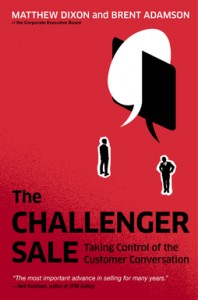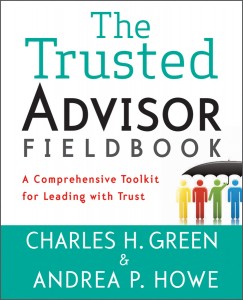 As an avid reader of military history, I’m very aware of the saying that: “Amateurs study strategy; professionals study logistics.” What this means is that it’s very easy to get caught up in the fun and interesting stuff, but if you want to really get things done, you have to master the detail and the boring day to day stuff such as processes, measurements and structures.
As an avid reader of military history, I’m very aware of the saying that: “Amateurs study strategy; professionals study logistics.” What this means is that it’s very easy to get caught up in the fun and interesting stuff, but if you want to really get things done, you have to master the detail and the boring day to day stuff such as processes, measurements and structures.
It’s the same with sales. Amateurs concentrate on the interesting stuff such as motivation, mental attitude and messaging. These are all important, but the reason we never run out of things to say about them is that the basic, boring stuff is being ignored.
Dan McDade is a professional. His book, The Truth About Leads, focuses on the stuff that only professionals care about, so it probably won’t become a runaway success in the sales world—and that would be a shame.
Sales and marketing are always pointing fingers at each other. Marketing complains that salespeople don’t follow up properly on the leads they give them; Sales responds that the leads are worthless. Both sides are right and both are wrong. The solution is for a separate group to provide fully nurtured leads, track their progress closely, and make salespeople accountable for following up.
Everyone focuses on lead generation, but they should work instead on lead nurturing. If you don’t care about quality, it’s easy to generate leads. But if you don’t care about quality (and programs that measure marketing’s contribution only by cost per lead send the implicit message that only quantity counts), those leads aren’t going anywhere when they hit the salesperson’s desk.
Salespeople are under tremendous pressure to produce short term results, so they’re not going to spend much time on activities that don’t have a high chance of paying off this quarter. According to McDade’s figures, 70% or more of leads are not being followed up by the sales force.
But if marketing focuses on only providing short-term leads, only about a third of those are “hot”, because often the buyer has already made a decision and just needs additional quotes as column fodder, or because by then it is too late to influence the decision process.
According to the book, 45% of qualified leads will buy within a year, but only 10% will close within three months. Time-pressured salespeople will not do what needs to be done to nurture the other 35%.
What does “fully nurtured” mean? Each lead had already been contacted at least eight times through various touchpoints and has graduated from unknown to near-term decision status. In addition, the salesperson received a complete contact history, overview of the decision process, timeline, budget and pain points. That type of qualified lead can’t be produced by low-budget telemarketers who are measured only by quantity or cost per lead.
His recommended solution is a group that is separate from marketing and sales that will specifically focus on identifying, nurturing and tracking qualified leads. That group can be internal, or you can outsource it to his own company, PointClear. (I have absolutely no problem with an author using his book to sell me on his company. In the best traditions of challenger selling, he is educating people about a real and significant problem that they only vaguely know they have, and most companies don’t have the ability, resources or the time to build their own internal lead nurturing capabilities. Besides, McDade is not “in your face” about it.)
While the first half of the book details the problem, the second half tells us what to do about it, and this is the part I really enjoyed. I took away some lessons and ideas for my own marketing efforts. He tells us to pay close attention to an integrated effort he calls M?O, or market, media and offer.
The market is one area that is definitely ripe for clear definition, segmenting and targeting. Quality leads are more apt to come from a smaller market that is tightly defined than one that is overly vague and broad. Again, quality counts.
Regarding media, the best approach is multi-media, multi-touch and multi-cycle. Most database marketers give up too soon and don’t avail themselves of multiple touch points. One surprising statistic he tells us is that senior level decision makers are 2.5 times more likely to return voice mails than are their subordinates. And, if you’re worried about leaving too many messages, think about how often it takes multiple phone calls just to set up lunch with a friend.
If you do leave a voice mail, your offer should talk as little as possible about your own product or solution and as much as possible about the prospect’s business goals and challenges. And, any marketing message should tell in clear English so that the recipient knows exactly what you sell and how you can help them.
There is one quibble I have with the book: a lot of his argument rests on the validity of the eye-opening statistics he provides, (such as the one about the likelihood of senior executives responding to voice mails) but he does not reference his sources. When an author tells me that “experts say” and does not identify those experts, I get a little nervous. I’m not questioning his figures, but I look at references as Reagan did the Soviets: “Trust, but verify.”
Despite that minor complaint, I recommend this book to anyone who is in a sales position of enough authority to influence the decisions that are made with regard to lead-generation efforts, or to sole practitioners like myself who can benefit from some of his very useful prospecting suggestions.
If you’ve been struggling to figure out what to give to someone who has everything, you’ve come to the right place. Everyone can always use a little extra personal influence, persuasiveness, or success in their lives, and I’ve compiled a list of some of my more recent reading for your shopping convenience. (Even if that special someone is you.)
General Influence
If you want to matter within your own organization, if you want to be a “go-to” person that others listen to, and if you want influence above your pay grade, you can’t leave it to chance. Here are three books that can help you make it happen.
The Art of Woo, by G. Richard Shell and Mario Moussa: this book is about Winning Others Over, and it emphasizes a strategic approach to getting your ideas accepted. Persuasion is a process which occurs over time, and this book provides a four-step process to ensure success.
Power, by Jeffrey Pfeffer: Pfeffer is one of my favorite business writers, and unlike others who have been writing for a long time, his newest book ranks among his best work. Power is Machiavelli in modern terms, reinforced with current management thought and social psychology. It’s also a useful and refreshing balance to so much writing today that shies away from straight talk about what actually happens in organizations and what it really takes to get ahead.
Just Listen, by Mark Goulston: Just Listen focuses on interpersonal conversations—on ways to get through to yourself first and then to others by understanding them, and relating to them in ways that make them feel understood and appreciated.
Presentations and Speaking
Most books about presentations are based on the author’s experience and little else. These books made the list because, in addition to excellent advice, they are backed up by solid and extensive research.
Resonate, by Nancy Duarte: For “ballroom” type presentations, this beautifully-designed book shows you how to engage an audience through story and compelling visuals. Duarte shows you how to create stories that provide strong emotional appeal to your message.
Speaking PowerPoint, by Bruce Gabrielle: Gabrielle’s book is a useful balance to Resonate, because sometimes stories and pictures are not enough. Internal presentations are usually “boardroom” style, requiring more text and dense content that is discussed around the table. This book is as much about thinking how to express complex ideas as it is about creating slides.
Advanced Presentations by Design, by Andrew Abela: This book also focuses more on the analytical side of presentations, and shows you a systematic approach to craft thoughtful content-rich presentations in a business environment.
Sales
The three books listed below share a common theme: there is no substitute for a knowledgeable and trusted sales professional who can bring solid business improvement ideas to their customers.
The Challenger Sale, by Matthew Dixon and Brent Adamson: Extensive research shows that top-performing salespeople challenge their customers with fresh insights about how to improve their business. Their goal is not to “please” customers but to create constructive tension in the conversation, centered around their own unique advantages.
The Trusted Advisor Fieldbook, by Charles H. Greene and Andrea Howe: Challenging your customers won’t work if they don’t trust you. Trust between individuals is one of the most essential and important ingredients of personal influence. Of course, you don’t need a book to tell you that. The critical point is that trust is also within your control, and this excellent book shows you how to establish, accelerate, and maintain it.
Bottom-Line Selling, by Jack Malcolm: Conflict of interest alert! It’s probably not fair to put my own book on this list, but I truly believe that every sales professional in the complex sale needs the depth of business and financial acumen this book provides. Besides, it’s my blog and I can do whatever I want.
Individual Success
By now you’ve figured out that I’m biased toward books that are based on empirical research. Nowhere is this needed more than in the literature of personal success.
Succeed, by Heidi Grant Halvorson: We all know it’s important to set goals, but it also matters what kind of goals we set, and how we set about achieving them. Succeed is useful because it gives scientific backing to “common sense”, but also corrects some misleading or even harmful common sense we take for granted. Read it for a lot of practical advice and techniques you can use immediately.
Any of the following: One of the most important ideas that comes out of recent research is that talent, ability and ultimately success are so much under our own control, if we’re willing to do the work. I had trouble deciding which of these excellent books to leave out, so I’ve put them all in; every one is worth reading:
Mindset, Carol Dweck
Talent is Overrated, Geoffrey Colvin
The Talent Code, Daniel Coyle
The Genius in All of Us, David Shenk
Bounce, Mathew Syed
 This book, by Brent Adamson and Matthew Dixon, comes very highly touted, especially by Neil Rackham himself, who calls it “the most important advance in selling for many years.”I’d restrain my enthusiasm a little short of that description, but overall it is an excellent book, with provocative insights and useful information for salespeople looking for ways to break out of the pack, especially in difficult economic times.
This book, by Brent Adamson and Matthew Dixon, comes very highly touted, especially by Neil Rackham himself, who calls it “the most important advance in selling for many years.”I’d restrain my enthusiasm a little short of that description, but overall it is an excellent book, with provocative insights and useful information for salespeople looking for ways to break out of the pack, especially in difficult economic times.
The key to a really good book is that it makes you say, “I never thought of that before,” and to use that insight to improve your life in some way. Interestingly, that’s also the key to a really good salesperson, as well.
 Trust between individuals is one of the most essential and important ingredients of personal influence. If motivation is the fuel of persuasion, trust is its lubricant. Trust lowers risk; it opens communication; it makes decisions more efficient and effective.
Trust between individuals is one of the most essential and important ingredients of personal influence. If motivation is the fuel of persuasion, trust is its lubricant. Trust lowers risk; it opens communication; it makes decisions more efficient and effective.
Of course, you don’t need a book to tell you that. The critical point is that trust is also within your control, and this excellent book by Charles H. Green and Andrea P. Howe shows you how to establish, accelerate, and maintain it.
Whether or not you are in sales, you exert influence and make a difference in others’ lives when they take your advice—but even if you are always right it’s no guarantee that people will take you advice. (And you don’t have to have teenage kids for this to be true.) As the authors tell us, you have to earn the right to be right.
The Trusted Advisor Fieldbook shows you how by opening up the black box and exposing how the process works so that you can become more trustworthy to others. It then goes into specific practical detail on how to apply the trust principles in everyday situations, from different aspects of the sales cycle to personal and organizational relationships.
Most “how-to” books such as this provide value on three levels:
- Things you already “know” you should do but need reminding or prompting to do more of
- Things you kind of know how to do, but get expert instruction on how to do it better
- Things you thought you knew, but were wrong
The fieldbook has a lot of material in the first category, but to me the most important reminder is worth quoting at length:
“The goal of traditional selling is to convince the buyer to buy from you—the goal of trust-based selling is to help the buyer do what is right for him. The difference is a question of focus and motives. Helping, as distinct from closing, is other-focused, nonmanipulative and trust-enhancing.”
I believe this quote could encapsulate the entire book, and because one of my pet causes is the professionalization of selling, I urge any salesperson reading this article to print this and post it somewhere that you can see it before any communication with a client or prospect. Even if you’re not in sales, change the words slightly and they will apply equally to you.
In the second category, there are a number of specific situations, including presenting, selling to the C-Suite, and negotiating, where they give useful advice and excellent insights. Most importantly, the examples of the phrases they provide to illustrate their points ring true, and demonstrate that the authors have very deep experience in these areas.
As to the third category, I pride myself on being right, and this is awkward to admit, but I may have to reconsider my traditional advice to keep price out of the discussion until the end. The authors make a convincing case that this just adds to the tension and angers the potential buyer; it’s best to let the buyer control when the topic comes out in the discussion.
Finally, I like the format of the book. In the form of a fieldbook, it provides numerous questions, forms and suggestions to think further about how to apply their ideas to your own particular situation. The “list of lists” at the end is also helpful; I found it easier to read them before beginning a new chapter.
I trust you will get a lot of value out of this book.



